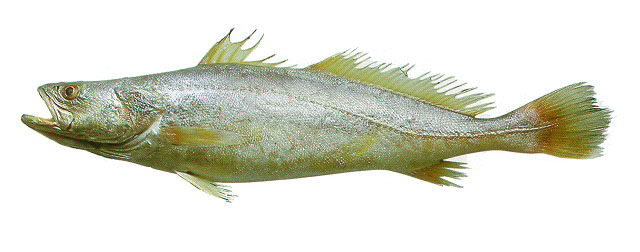| Sciaenidae (Drums or croakers) |
| 115 cm TL (male/unsexed); max.weight: 4,350.0 g |
|
demersal; brackish; marine; depth range 6 - 70 m |
| Western Atlantic: Nicaragua to Santos, Brazil. |
|
Dorsal spines (total): 11-11; Dorsal soft rays (total): 27-31; Anal spines: 2-2; Anal soft rays: 8-8. Greyish to brownish above, silvery below. Upper sides sometimes with inconspicuous minute dark dots. Dorsal fin dusky, its spinous portion black-edged. Soft dorsal fin with dark spots on each ray. Pectoral and pelvic fins as well as anal fin yellowish to orange. Caudal fin dusky. Inside mouth orange. Mouth large, distinctly oblique, lower jaw projecting. Upper jaw with a pair of large canine-like teeth at tip. Chin without barbels or pores. Snout with 2 marginal pores. Gas bladder with a pair of long, curved, horn-like appendages. Sagitta (large earstone) elongate, with a notch on dorsal margin. Soft portion of dorsal fin membranes unscaled except 2 or 3 rows of scales at base (Ref 51721). |
| Usually found over sandy mud bottoms in coastal waters near river mouths (Ref. 3702). Adults stay in deep waters during the day and swim to the surface at night (Ref. 35237). Juveniles inhabit estuaries. Marketed fresh; its flesh is of excellent quality (Ref. 3702). Its swim bladder is being used to make glue (Ref. 35237). |
|
Least Concern (LC); Date assessed: 15 January 2020 Ref. (130435)
|
| harmless |
Source and more info: www.fishbase.org. For personal, classroom, and other internal use only. Not for publication.
